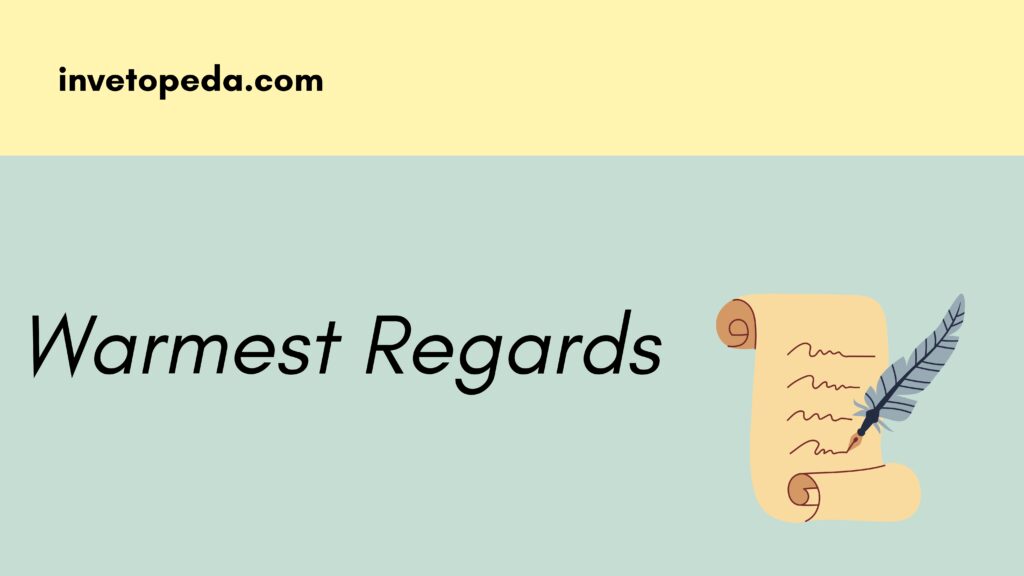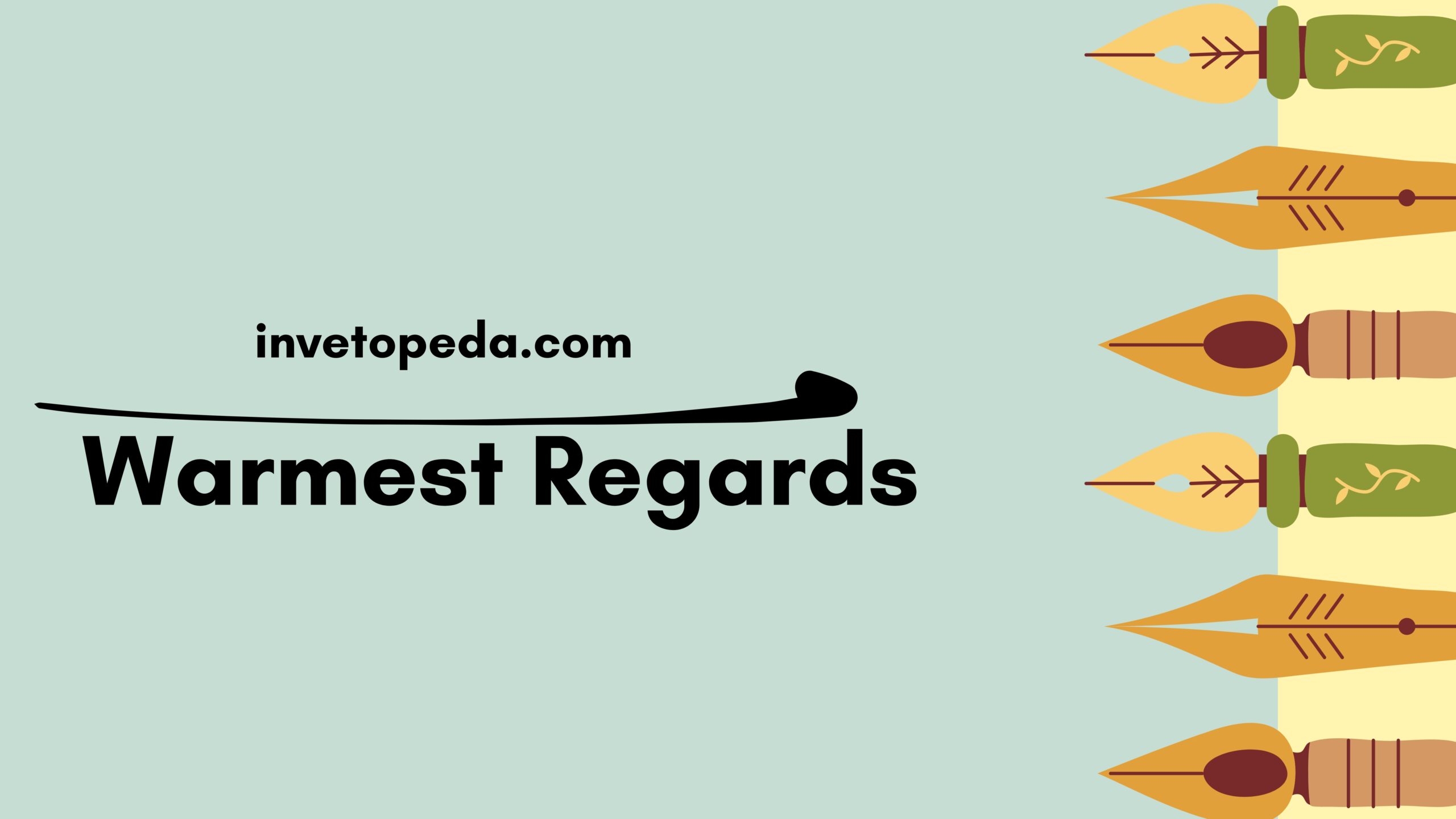When you close the note or email, the manner in which you conclude your email is much, far more significant than you imagine. This is the last impression your viewers will get and can impact your perception of who you are. One of the most well-known and trusted options for closing your letter is to say, “Warmest regards.” It’s friendly, professional and professional. However, sometimes, you’ll want to say your feelings in different ways. Using a more formal approach and with more sacramental warmness or even an ounce of imagining. In this blog, we’ll discuss 13 great options for “Warmest Regards,” each with its distinct design and style, and specific usage.
1. Best Regards
“Best regards” is one of the most popular alternatives to “Warmest regards.” It’s professional and nevertheless communicates in a warm and welcoming way. This can be utilized in any formal business or formal communications. This can be particularly useful when you do not know the person quite well, or you need to keep your professional tone but not overly emotional.
2. Kind Regards
Kind regards is an informal form of Best regards but at the same time still professional. The closing “Kind regards” is universal among the British English and the emails that have the aim of conducting the business have achieved a tremendous acceptability of the signature. It is a great choice for those, who need to express their friendly, considerate style and sound not that personal.
3. Warm Wishes
If you desire to address a letter to a person with whom you have a friendship, then you should choose the phrase, “warm wishes”. It is a manner of displaying respect and love and the reason why it is preferable during Christmas greetings such as the friendly notes or messages as a form of thanking the individual you adore. Not as classy as Warmest regards, but considerate enough.
4. Sincerely
If you’re writing a formal commercial letter, particularly for job applications and formal demands in addition to matters of law, “Sincerely” is an excellent way to close your letter. It’s one of the more traditional closures that communicate clarity and integrity. The tone doesn’t seem sentimental. However, it is refined and professional.
5. Yours Truly
The other commonly used sign-off in North American formal writing is the one tagged as “Yours truly”. It is less official than “Sincerely” yet it fits in a formal or semi-formal environment. It generates a feeling of authenticity and confidence. One can quite frequently find it in the recommendation letters or persuasions and even thank-you notes.
6. With AppreciationAppreciation
If your letter contains or conveys gratitude. “With appreciation” can be the perfect end. It is a way to express gratitude, and it’s acceptable for formal and semi-formal occasions. This is an excellent method to express gratitude for someone’s help or to thank a client who you’ve recommended to the business.
7. All the Best
“All the best” strikes an ideal balance between friendly and professional. It’s an excellent alternative for informal messages; for instance, when messaging your colleagues or customers, you stay in contact with your friends. It shows you’re wishing the people you know a Happy Birthday however, you don’t appear too personal or unengaged.
8. Take Care
In the case you are talking to someone closely intimate and they are receiving it, “Take care” is the best solution, relax and sweet and simple to you as you are expressing your sorrow. It is a great way of demonstrating the fact that you really care about the wellbeing of another person. This is most suitable for fan mail or messages.
9. Cheers
Cheers is one of the common but casual closings that are used to conclude a conversation in British English. Although on the one hand sending official email in business may be a bit uncomfortable, it is the best substitute to informal and casual communication, which is especially true when it is employed in cooperative disciplines and between co-workers. It is a sign of being amiable and it is an informal form of communicating.
10. Respectfully
Respectfully can be the best word to use when you are writing to a person in an authoritative position and handling issues which are sensitive. The sign-off is official and respectful. This sign-off is normally applied in official, military or legal documents.
11. Fondly
Fondly is a lot more personal compared to the other numerous options. It expresses love and warmth. It is excellent to be used on personal emails or letters. Such as a close friend of one of the instructors, an acquaintance, some relative of yours. It is not a very suitable choice in most places of work but a very good choice to have notes to yourself.
12. With Best Regards
It’s a slightly more refined version than “Best regards.” It adds a bit of humor without diminishing professionalism. This is an excellent option for informal business letters, proposals, and follow-up messages where you’re trying to maintain the warmth and friendliness of your message.
13. Sending Warmth
It is a special, individual and confined way to finish the day. It relays the Warmth of the individual. The best application of sending warmth includes using it in personal messages or business emails that are cordial, particularly in the area of wellness, and customer care as well as coach. This is not the common way of concluding an exchange but this is the phrase that is sincere and full of emotion.
When to Use “Warmest Regards”
“Warmest regards” is appropriate in a myriad of different situations and settings. Still, it is particularly appropriate when you need to be in a position to achieve the right balance between friendly and professional. It’s more intimate in comparison to “Best regards,” yet it’s not as private as “Fondly” or “Take care.” It’s great to:
- Emailing long-time coworkers or clients
- Appreciation messages
- Professional Follow-ups
- Seasonal or holiday wishes or a warm greeting
Whether you are formal in a letter or talking to someone of higher stature in the society that you do not know, a conventional sign off like, Sincerely, Respectfully, would do better.
Why It’s Important to Choose the Right Sign-Off
It is not only a single expression. It influences the tone and content of the email. The right closing option will transfer you professionally, create rapport with your audience and tell them that your message will be received the way you want it to receive. Either intentionally or not, when you are writing an email to a coworker, a boss, among others, including a potential customer, the email address you use at the end, may end up reflecting respect.
Example:
- Too formal. Could look far away or uninviting.
- It could come across as childish
- and overly emotional, and it could feel unsuitable even in business settings.
That’s why using a collection of professional and semi-professional closings could be beneficial. It’s possible to customize your tone to suit the audience that will hear the content and stage of knowledge.

Final Thoughts
The decision of when to shut an email can be an easy choice. It’s an important choice. “Warmest regards” is a sensible, well-balanced, and efficient way to close your emails in a range of circumstances. It’s, however, not the only choice. These 13 choices offer diverse tones, which range from formal, casual, and informal to soft. Take into consideration different alternatives depending on the type of relationship between you and the person who is receiving your message, as well as the motivation behind your message as well as your ideal way to present yourself.
If you personalize the closings of your emails in this manner, it will allow you to show the highest competence and trust; however, you can also distinguish yourself from the sea of regular email messages. While wrapping your email, consider dropping “Warmest regards” for one of these well-chosen alternatives. It could enhance your communication by just a couple of points. It is more effective.

